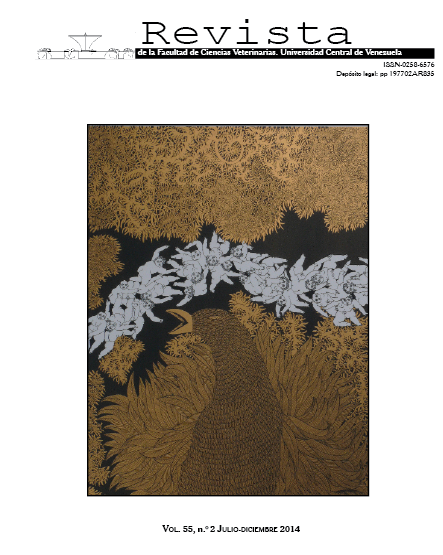EFECTO DE UN SECUESTRANTE DE MICOTOXINAS SOBRE LA PRODUCCIÓN DE GAS Y DEGRADACIÓN RUMINAL IN VITRO DE HARINA DE MAÍZ CON AFLATOXINA B1
Contenido principal del artículo
Resumen
Con el propósito de evaluar el efecto de un secuestrante comercial de micotoxinas (SM) con base en glucomananos, sobre la producción de gas y degradación ruminal in vitro, se incubó harina de granos de maíz (Zea mayz L.) en licor ruminal con concentraciones de aflatoxina B1 (AFB1) de 4, 8 y 12 ppb, respectivamente, y proporciones de AFB1: SM de 1:75000 (SM-75), 1:150000 (SM-150) y 1:225000 (SM-225). Adicionalmente, se consideró un tratamiento sin inclusión del secuestrante de micotoxinas (SM-0). La producción de gas se registró a las 3, 6, 9, 12, 16 y 24 h, y la actividad del SM a las 3 h de incubación. La información fue analizada utilizando un diseño completamente aleatorizado con arreglo factorial 3x4. La concentración de AFB1 afectó negativamente (P<0,05) la producción de gas, con el mayor impacto a las 9 h, cuando 12 ppb [5,15 mL/g de materia seca (MS)] generaron una reducción en la producción de gas, en comparación con 4 y 8 ppb (6,57 y 6,01 mL/g MS), respectivamente. Independientemente del nivel utilizado y luego de 24 h de incubación, el uso de SM incrementó (P<0,05) la producción de gas respecto al SM-0 en 25,5% (68,5 vs. 56,6 mL/g MS, respectivamente). En todos los tratamientos, SM-75 mostró la mayor producción de gas, sin mejoras debido a aumentos adicionales en la relación SM:AFB1. La concentración de AFB1 afectó (P<0,05) negativamente la degradación de la MS de la harina de maíz, con una reducción del 39,8%, luego de 12 h de incubación. La capacidad secuestrante fue del 86,0 ± 3,34%, sin diferencias (P>0,05) debida al nivel de AFB1 o a la relación AFB1:SM. Estos resultados demuestran que el aditivo biotecnológico evaluado, reduce el impacto negativo de la AFB1 sobre la producción ruminal in vitro de gas y la degradación aparente de la MS.
Abstract
To evaluate the effect of a commercial mycotoxin binder (MB) based on glucomannans, on the in vitro gas production and ruminal degradation, maize (Zea mayz L.) grain meal was incubated in ruminal liquor with aflatoxin B1 (AFB1) concentrations of 4, 8 y 12, respectively, and proportions of AFB1: MB of 1:75000 (MB-75), 1:150000 (MB-150), and 1:225000 (MB-225). Additionally, a treatment without MB was considered (MB-0). Gas production was measured at 3, 6, 9, 12, 16, and 24 h, and MB activity after 3 h of incubation. Data was analyzed using a completely randomized design with a 3x4 factorial arrangement. The results show that gas production was negatively affected by AFB1 concentration (P<0.05), with the higher impact at 9 h, when 12 ppb [5.15 mL/g of dry matter (DM)] generated a reduction, when compared to 4 and 8 ppb (6.57 and 6.01 mL/g of DM, respectively). Regardless of the level used and after 24 h of incubation, the use of MB increased (P<0.05) gas production in 25.5%, compared to SM-0 (68.5 vs. 56.6 mL/g of DM, respectively). In all treatments, MB-75 showed the highest gas production without improvements, due to further increases in the ratio MB: AFB1. The AFB1 concentration negatively affected (P <0.05) degradation of DM of maize meal, with a reduction of 39.8%, after 12 h of incubation. The binding capacity was 86.0 ± 3.34%, without differences (P<0.05) due to AFB1 concentration or AFB1: MB relation. These results demonstrate that the assessed biotechnological additive reduces the negative impact of AFB1 on the in vitro ruminal gas production and apparent DM degradation.

